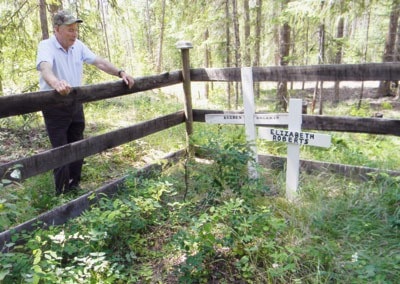As residents and visitors enjoy the idyllic days of late summer on Canim Lake, it is easy to imagine the land and its people have always been more or less as they are seen now.
But there are many stories from past years that flit through the shadows, resting only in the memories of the few longtime residents. They remember when life here was not so gentle, when young families with big dreams spent their energies opening the country against tough odds.
Garry Baker recently took me on a drive back in time east on the Canim Lake South Road and up into the highlands behind Mt. Mahood. As we drove, he pointed out special places and recounted stories of the early days of logging.
He told me the lakeside road was not finally completed until 1973. Garry did the first grading after the bulldozer had chewed the road bed off the side of the mountain between Paul’s Point and the Jens’ Brothers mill located where Art Dumaresq lives today.
He then drove the first load of Mahood Lake timber out to the mill. At first, it was merely a winter tote road with no gravel or culverts and run on a one-way basis for safety sake because the trucks had no radios. Loaded trucks drove west to the mill and then returned to Mahood around the long way via Hathaway Lake.
At Jim Creek, we passed the McNeil ranch. That land was purchased by Benjamin McNeil in 1908, and settled by him and his wife, Laura, in 1916.
The couple had two sons, Benjie and Herbie. As time progressed, Benjie established a lodge on Mahood Lake, while Herbie focused on the ranch.
Benjie and his wife had seven children who worked the lodge until selling it to the Jens family in 1960. Later that year, the property passed to the government of British Columbia and is now the Mahood Lake Campground of Wells Gray Park.
Next, we passed the cairn at the junction of the Red Creek and Mahood Lake roads. Lynne Baker says that this was erected by the community during a big picnic on the occasion of the Centennial of B.C. in 1968.
A short way on, we passed Roserim Lake. The first driveway past the lake once led down into the valley where the home of Ken Higgins and his wife, Mary, nestled.
Ken was son of well-known pioneer Ed Higgins and brother to Noveta Higgins, the subject of Marianne Van Osch’s book, The Homesteader’s Daughter.
Ken worked as the roads foreman for the area, as well as raising beef cattle and growing hay. Mary was the Mahood Falls postmistress. Their daughter, MaryAnne Shaw-MacLaren, recalled her mom making the weekly trip over the rough and muddy road out by Hathaway Lake to the postal depot in Lone Butte to pick up the mail.
The people of the area would line up in the yard waiting for the 7 p.m. opening of the office. It made for a long day, she said, especially when Christmas parcels started to arrive.
Further along, at the junction with the Bowers Lake Road, the old Mahood Falls teacherage hides in the trees behind a large spruce. It was built in 1952 by the men of the community with McNeil lumber, to house Mrs. Patti Law, the second teacher at the school.
A few hundred metres east of that, a small lane, which is difficult to see, leads off to the north. Within a stone’s throw, the drive opens into the clearing in which the Canim Lake East School reigned from 1951 to 1989.
The school yard and ball field have now reverted to meadow. Bees buzz lazily among the wildflowers and young pine sprout on the verges of the quiet clearing where once the voices of delighted children rang.
Continuing east, on a shady knoll in sight of the Red Creek Bridge, the graves of Rueben (Rube) and Elizabeth Roberts lie, marked with white crosses and surrounded by a board fence. The couple owned a large parcel of land there in the mid-1900s.
Garry and I back-tracked then, and turned up the Bowers Lake Road, making the first turn left, onto the old 810 Road. A few kilometres in, just after crossing Red Creek, he stopped the truck and led me into the bush.
A few steps through the sun-dappled woods, we found the old corner stones of the cabin Garry moved to the site in 1959 for him and his bride, Lynne, the daughter of Benjie McNeil. The couple located there to be close to the mill Benjie operated in the highlands south of Mahood Mountain, making the first cut of large trees which produced the timber Garry hauled to the mills.
The couple’s first two children, Joanne and Jim, were born there. Lynne’s older sisters, Joan with her husband Bob Uhrig, and Donna with her husband Andy Erickson, settled across the road from them, forming a small community.
Lynne says that within a 10-mile radius, there were other families. She and her sisters would meet regularly with the women of the Higgins, Kuros and Hogan families in a gathering they called “The Jolly Hours.”
Life has moved on since those early families busied themselves with opening a new land. Few of the children remain in the area. The forest has grown up to be cut again.
What has remained, though now dispersed to settle in other places, are the values of hard-work, self-reliance, and community that fueled the first families that settled Canim.
